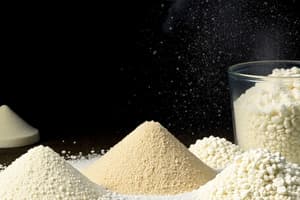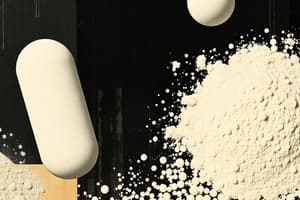Podcast
Questions and Answers
Which of the following are steps involved in formulation techniques for powder dosage forms? (Select all that apply)
Which of the following are steps involved in formulation techniques for powder dosage forms? (Select all that apply)
- Filtration
- Compression (correct)
- Granulation (correct)
- Particle size reduction (correct)
What is the purpose of particle size reduction in powder formulations?
What is the purpose of particle size reduction in powder formulations?
To improve dissolution rate and enhance bioavailability.
Which method is suitable for high-volume mixing of powders?
Which method is suitable for high-volume mixing of powders?
- Trituration
- Spatulation
- V-blender (correct)
- Mortar mixing
Wet granulation involves the use of a liquid binder.
Wet granulation involves the use of a liquid binder.
What is an important factor to consider during the compression process of powders?
What is an important factor to consider during the compression process of powders?
Which of the following types of tablets avoid granulation?
Which of the following types of tablets avoid granulation?
Proper ______ is crucial for powder handling.
Proper ______ is crucial for powder handling.
Excipients are used to enhance the stability and bioavailability of powders.
Excipients are used to enhance the stability and bioavailability of powders.
What is a critical consideration when packaging powders for stability?
What is a critical consideration when packaging powders for stability?
Flashcards
Powder Dosage Forms
Powder Dosage Forms
Solid dosage forms of finely divided drug substances and/or excipients. Administered orally, topically, or by inhalation.
Particle Size Reduction
Particle Size Reduction
Process of decreasing particle size to improve dissolution rate, bioavailability, drug-excipient interactions.
Milling
Milling
Mechanical process to reduce particle size using devices like ball mills or attritors.
Mixing (Powders)
Mixing (Powders)
Signup and view all the flashcards
Granulation
Granulation
Signup and view all the flashcards
Compression (Tablets)
Compression (Tablets)
Signup and view all the flashcards
Flowability
Flowability
Signup and view all the flashcards
Excipients
Excipients
Signup and view all the flashcards
Segregation
Segregation
Signup and view all the flashcards
Inhalation Powders
Inhalation Powders
Signup and view all the flashcards
Study Notes
Introduction to Powder Dosage Forms
- Powder dosage forms are solid dosage forms consisting of finely divided drug substances and/or excipients.
- They offer advantages like ease of administration, stability, and cost-effectiveness.
- They can be administered orally, topically, or by inhalation.
- Different types of powders exist for different therapeutic needs.
Formulation Techniques for Powder Dosage Forms
- Formulation techniques involve several steps:
- Particle size reduction (micronization, milling)
- Mixing of components
- Granulation (for improved flowability)
- Compression (for tablets)
- These processes are essential for ensuring desired properties of the powder.
Particle Size Reduction
- Techniques:
- Milling: Using mechanical devices (e.g., ball mills, attritors) to reduce particle size.
- Micronization: Using high-speed processes (e.g., jet mills, fluid energy mills) to produce extremely fine particles.
- Purpose:
- Improve dissolution rate.
- Enhance bioavailability.
- Increase surface area for better drug-excipient interactions.
- Factors to consider:
- Drug properties (e.g., solubility, stability)
- Desired particle size range
- Equipment limitations
Mixing
- Methods:
- Spatulation: Gentle and suitable for small-scale operations.
- Trituration: Manually grinding powders in a mortar.
- V-blender: Suitable for larger volumes.
- Ribbon blender: Effective for high-volume mixing and uniform dispersion of ingredients.
- Purpose:
- Ensure uniform distribution of drug and excipients.
- Minimize segregation.
- Factors to consider:
- Particle size, shape, and properties of ingredients.
- Type of powders (e.g., hygroscopic, reactive).
- Mixing time, equipment limitations.
Granulation
- Methods:
- Wet granulation (using a liquid binder).
- Dry granulation (without a liquid binder).
- Purpose:
- Improve flowability and compressibility.
- Minimize powder segregation.
- Enhance dissolution rate.
- Considerations:
- Proper selection of binders, lubricants, and other excipients.
- Control of moisture content throughout the process.
Compression
- Purpose:
- Compacting powders into tablets to improve stability and ease of administration.
- Formulation of multi-component powders into compact and unified structures.
- Process:
- Compression using tablet presses.
- Factors to consider:
- Granulation characteristics
- Tablet hardness, disintegration time, and friability
- Specific types of tablets:
- Direct compression tablets: Avoiding granulation for simple formulations.
- Sugar-coated tablets, film-coated tablets, and other types of coated tablets.
Other Critical Formulation Considerations
- Flowability:
- Proper flowability is crucial for powder handling.
- Angle of repose
- Segregation:
- Variation in particle properties can lead to segregation during storage. Minimizing or preventing the segregation of powders is crucial for uniformity of dose across each product.
Excipients in Powder Formulations
- Purpose:
- Improve flowability and compressibility.
- Enhance stability and bioavailability.
- Reduce adverse effects.
- Types:
- Fillers (e.g., lactose, starch).
- Disintegrants (e.g., starch, crospovidone).
- Lubricants (e.g., magnesium stearate).
- Glidants (e.g., colloidal silica).
Stability and Packaging
- Stability:
- Powders can degrade due to moisture, light, or exposure to high temperatures.
- Stability testing is necessary to monitor drug degradation.
- Packaging:
- Protection from environmental factors (moisture, light, air).
- Airtight containers to maintain stability.
- Specific container needs for individual powders.
Quality Control
- Testing procedures:
- Particle size analysis.
- Flow properties assessment.
- Uniformity of content testing.
- Maintaining quality:
- Monitoring and controlling each step of the manufacturing process.
- Regularly checking and documenting powder characterization.
Inhalation Powders
- Specific Considerations:
- Fine particle size is critical.
- Use of specialized devices.
- Formulation techniques to produce fine and homogenous powder.
Studying That Suits You
Use AI to generate personalized quizzes and flashcards to suit your learning preferences.




